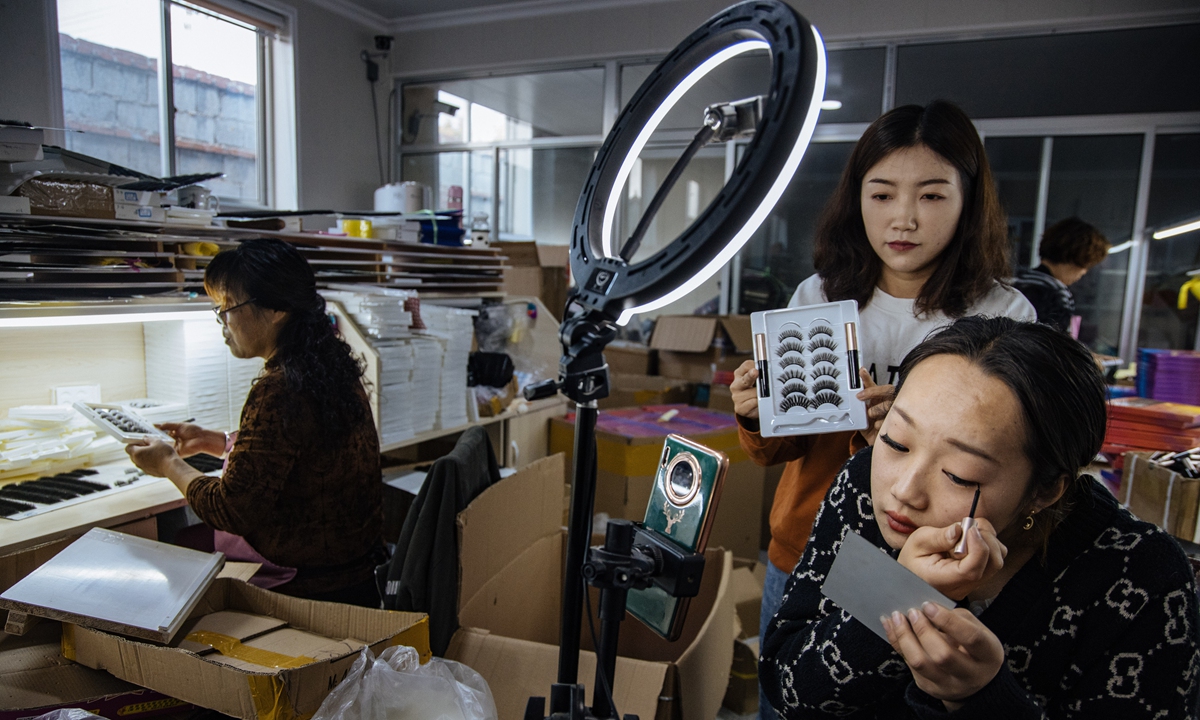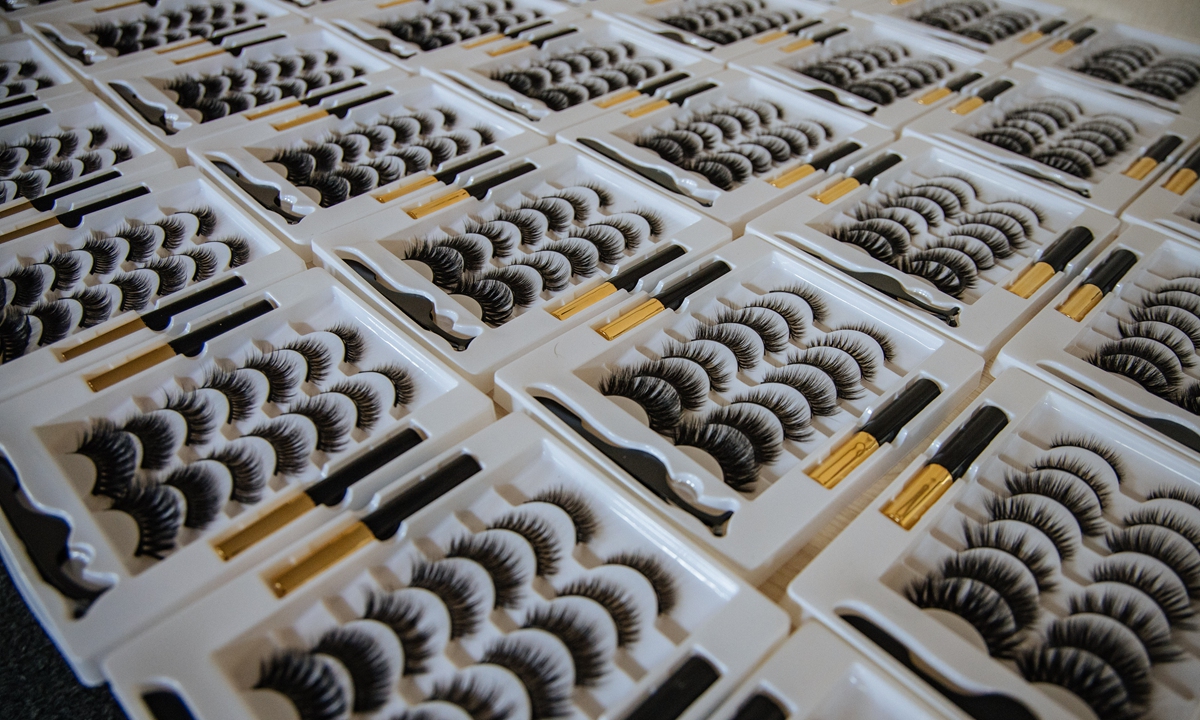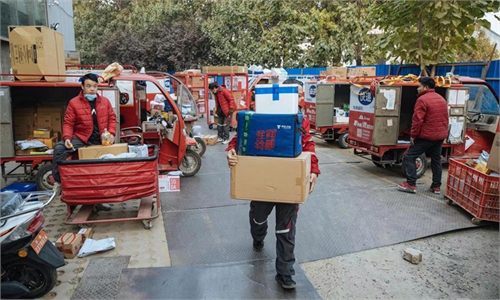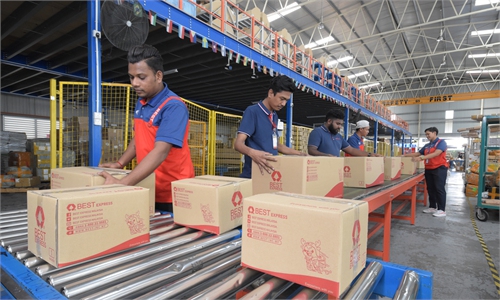The world’s capital of eye decoration unfazed by pandemic impact
False eyelash, real charm

Two female workers introduce their products through livestreaming. Photo: Li Hao/GT

False eyelashes produced in a Pingdu factory Photo: Li Hao/GT
Workers, mostly women, sit behind the tables in workshops and repeat moves like cutting and gluing lines of materials for false eyelashes attentively and quickly. They are trying to finish a huge backlog of orders from the 2020 Double 11 shopping spree as fast as they can.
This is the scene in a factory with three workshops located in a town of Pingdu, East China's Shandong Province, where a cluster of over 860 manufacturers of false eyelashes supply about 70 percent of world demand.
When speaking of the ongoing COVID-19 pandemic, Chen Chunjie, manager of the processing factory, told the Global Times that he did not feel the negative impact of the outbreak. "Our orders from the online shops of e-commerce platforms including Tmall, JD.com and even Amazon have not been affected," he noted.
Chen's statement was validated by the constant ringing of his phone during the interview. He could hardly answer a question without being interrupted by a phone call or WeChat message.
Chen was busy discussing the styles and sizes of false eyelashes and packing boxes on the phone with his business partners.
Post-pandemic business
Although the pandemic has not affected online orders of false eyelashes, whether domestic or overseas, the breakdown of cross-border transportation links and even the lockdown, sometimes of a whole country, have had some impact on the industry chain of false eyelash, a product used predominantly in Western countries for parties and other occasions.
The most obvious change is that the easier production steps need to be transferred from overseas back to the home factory.
Chen said that before the epidemic, the first two steps - arranging each stick of eyelash to a line and cutting lines of false eyelashes to accurate length - could be completed in countries such as Vietnam, North Korea and Bangladesh.
"They have cheaper labor. To save the cost, our factory established an agency in North Korea."
There are several shops in the town that offer semi-finished products of false eyelashes from North Korea to processing factories.
But the pandemic froze international transport, so these factories like Chen's have to complete all the production steps by themselves. As Chen said, the orders have not been disrupted. "We also have skilled workers who can cover the two steps."
Yuan Feifei, manager of a local foreign trade company under Alibaba's cross-border e-commerce platform, found that the amount of orders from overseas physical stores has decreased, especially orders from the US.
"Before the pandemic, the orders from the US accounted for more than 60 percent of our platform, but it dropped to about 40 percent after mid-to-late August this year," Yuan explained.
Last year, her company began to receive orders for Christmas since September. These holiday-special false eyelashes are more colorful and have more exaggerated styles for parties.
However, this year, "we have received few Christmas orders till now. The pandemic does not allow them to gather together even during festivals. One of our customers in Florida told us her shop had to be closed."
False eyelash capital
The industry of false eyelash in the small town started 20 years ago, when some South Korean merchants went to Pingdu to build factories as Shandong is close to South Korea. These merchants brought along the production technology with them.
Chen said that the industry actually began booming in 2018, and this year, it has entered a period of prosperity.
"In 2018, the production technology was improved and the styles of false eyelashes became diverse and layered, attracting a large number of younger consumers and sharply increasing the sales," he added.
The annual output value of the false eyelash industry in the town can reach more than 4 billion yuan ($610 million), accounting for 80 percent of the national output and 70 percent of the global market share, according to the official data from the government of the town.
The false eyelash industry supports the whole town, solving the employment problem for at least 10,000 residents.
In Chen's factory, most of the workers are women belonging to different age groups, from 20s to 70s.
Two 70-something senior females packed boxes for products in the workshop. Chen said they work part-time in his factory and can finish such easy jobs.
Besides the US orders, Australian orders also account for a large share of Yuan's business. Those from some European countries including Italy and France make up for less than 20 percent.
"I remember a lady from the UK, around 50 years old, talking with me online after buying false eyelashes. She was very happy to wear the false eyelashes and said she feels much younger, like a 30-year-old woman." Yuan felt greatly satisfied after hearing this.
There are also troubles, especially when some clients are behind in payment. She said that once a US customer ordered products worth about $1,000, but in the end, she was told that because of the COVID-19 pandemic and hurricane, they had a big loss and could only pay $800.
Development of the industry
The local government pays much attention to this pillar industry. A giant wholesale market is being built near Chen's factory and Chen said that the market is scheduled to attract investment next year.
Local manufacturing and processing factories have researched how to improve the production order and technology. They are looking for a way to mechanization to save labor cost.
These producers are also investigating the tastes of domestic and overseas consumers for false eyelashes through international trading companies or e-commerce platforms, and continue to improve the styles.




